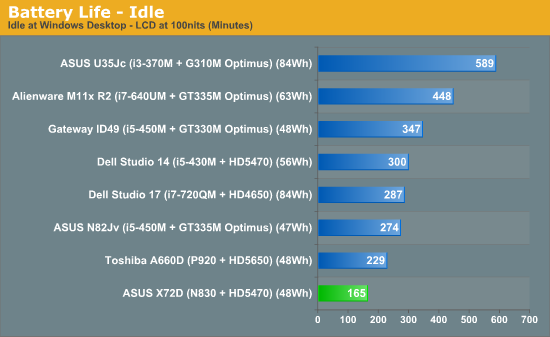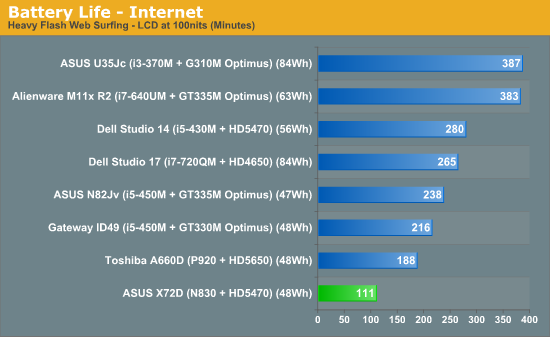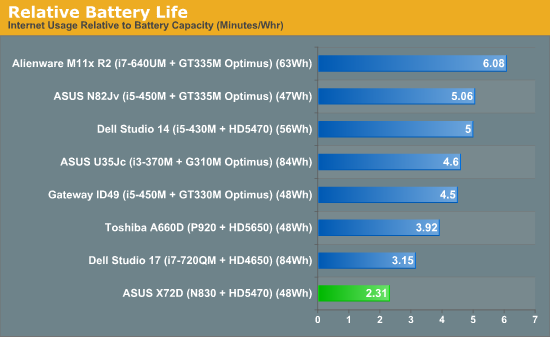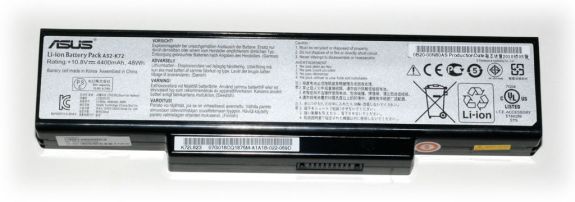ASUS X72D/K72DR: Three Cores, No Waiting
by Dustin Sklavos on October 25, 2010 12:01 AM ESTBattery, Noise, and Heat
We'll get this out of the way right now: between having to power a 17.3" screen, an AMD Phenom II tri-core processor, an RS880 Northbridge, an SB850 Southbridge, and the Mobility Radeon HD 5470, the anemic six-cell, 48Whr battery included with the ASUS X72D is hopelessly overmatched.




Given that the X72D is so substantial to begin with, it's difficult to imagine too many situations where you'd want to run it unplugged. That's good, because it isn't going to last that long anyhow: even completely idle and with the wireless off the X72D can't eke out three hours of running time. When tasked with media playback, you'll be lucky to finish a movie. This notebook just wasn't made for running off of the battery.
In order to test noise and heat, we ran 3DMark06 in a continuous loop for an hour with HWMonitor running in the background. We recorded the results with HWMonitor.

The thermals aren't very good, but the X72D seems to be tuned to favor silence. Under load the fan would spin faster and was audible, but it was a fairly quiet whooshing sound and wasn't hugely distracting. Temperatures of the computing surface of the unit are actually perfectly fine under load; some heat does radiate off of the top left side of the keyboard (near the exhaust), but overall the unit at least feels cool under load. Still, this is another place where the increased form factor of the 17.3" chassis could have been better used to manage heat: a peak temperature of 91C on the processor cores may be within spec, but it's still high.











37 Comments
View All Comments
pattycake0147 - Monday, October 25, 2010 - link
FYIThere is a pricing row on the first page table, but the price isn't listed.
OneArmedScissorB - Monday, October 25, 2010 - link
"There's still a major stumbling block for AMD in terms of power consumption, though: an AMD-based notebook has to power both a northbridge and a southbridge, while most of this functionality is either handled by integrated hardware in Intel's mobile processors or by the single power friendly HM55/PM55 chip."Considering that there is a separate, 45nm chip fitting the exact definition of the traditional laptop northbridge chip in the dual-core Core iX CPU package, and that the Core 2 platform, with its multiple "inefficient" and "obsolete" chips still seems to be untouchable in battery life, that statement is riding a fine line between silliness and misinformation.
It doesn't surprise me one bit that AMD's laptops tend to use a bit more power. That's just what happens with a more complex GPU and more CPU cores. Why that would be more dependent on nearly identical northbridge and southbridge functionality is beyond me.
mino - Monday, October 25, 2010 - link
Seconded.JarredWalton - Wednesday, October 27, 2010 - link
I've updated the text to make it clear that it's not just having an extra chip, but having three AMD chips (which have traditionally not been as power optimized) vs. two Intel chips is a real concern. The AMD CPUs have always used more power (at least post Pentium M), and I don't think either the NB or SB is particularly power friendly. They're not horrible either, but having two chips doesn't do AMD any favors. Finally, toss in process tech and the result is less than ideal battery life.SteelCity1981 - Monday, October 25, 2010 - link
I really don't know why AMD calls these Phenom II's when they lack an L3 cache which puts it a lot closer to the Athlon II chips. It can get confusing and hard to tell each mobile cpu apart that AMD markets for advance users to tell apart let alone the avg pc user lol. Unlike their desktop chips line which is pretty cut and dry, their mobile chips on the other had are all over the place. You have the mobile Phenom II x4/x3/x2, the Athlon II X2/ Neo X2, the Turion II X2/ Neo X2 (which are basicly lower clocked Phenom II mobile cpu's now.) and the AMD single core V series that are all based on the same Champlain 45nm architecture.mino - Monday, October 25, 2010 - link
Same reason why Intel calls Lynnfield i7. Marketing BS.SteelCity1981 - Monday, October 25, 2010 - link
Yeah but in the mobile sector Intel's chips are a lot more clearer then AMD's to understand. Core i7 highend, Core i5 mainstream, Core i3 budget,vol7ron - Monday, October 25, 2010 - link
It's sort of like Back-to-the-Future III, it's really less like B2F II and more like Feival Goes West.GullLars - Monday, October 25, 2010 - link
Since this is a laptop offering SATA 6Gbps, i strongly suggest you run a bench round with C300 128/256GB in it.It would also be nice to see the PCmark scores of that compared to the original configuration and the competition.
Storage performance can be a real problem in laptops, so this could be a key selling point, at least for the version K72DR that does not include the mostly pointless price addition of a BD player.
ssj4Gogeta - Monday, October 25, 2010 - link
"Processor AMD Phenom II N830(3x2.1GHz, 45nm, 1.5MB L2, 35W)"
Why do you state it as 3 times 2.1GHz? The frequencies of the cores don't add up. 3 cores don't even mean linear scaling vs. 1 core. So technically it's incorrect.